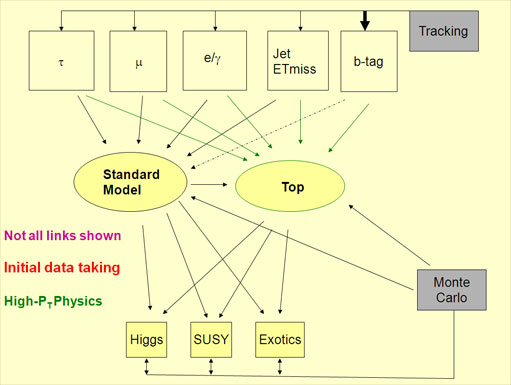
ATLAS e-News
23 February 2011
Focusing our working groups towards first data
Report from the Physics and Performance workshop
23 June 2008

From the slides of the concluding presentation
ATLAS faces some balancing issues as the date of the first collisions approaches. Too many collaborators are focused on looking for new physics in the data, and those preparing to interpret the signals of the detector are left shorthanded. Equally important, collaborators who are currently up to their ears installing and commissioning parts of ATLAS need to be integrated on the data analysis side as they finish.
In order to address these challenges, the physics coordination team arranged a Physics and Performance Workshop, held at CERN last week. “This is the start-up of a working group structure to really address the key issues of early data,” says Karl Jakobs, ATLAS Physics Coordinator. “We thought that our present structures were not ideal to do so.”
This was the kickoff to a series of meetings that aim to restructure the analysis work. The “combined performance” groups, in charge of turning detector signals into physics objects such as particles and jets, will be strengthened if the physics coordination team gets its way.
“It was well attended. Probably a few hundred people were there,” Karl estimates. “Certainly more than we usually see at these combined performance meetings.”
The general progression of the meeting, which ran from 9:00 Monday June 9th to lunchtime on Thursday June 12th, started with detector systems. Karl explains: “For example detector people were there describing the state of commissioning, the status of noise, of dead channels, and all that is relevant to understanding early data.”
Then, they moved on to the trigger, particle identification, and finished with preparing to search for new phenomena such as the Higgs boson and supersymmetry. The workshop placed special weight on Standard Model and top physics groups.
Karl justifies the emphasis: “You can only claim deviations from the Standard Model if you know how the Standard Model looks like.”
In addition to studying the properties of the heaviest quark, the top group is critical to understanding background signals from top pair production in searches for new physics, as the LHC will produce top quarks in force.
Karl deems the meeting a success. “I see things moving in the right direction,” he says, referring to people in physics groups moving toward combined performance groups. He hopes to eventually see people currently working on the detector join the combined performance groups as well, but at the moment, they are “still too busy getting the detector debugged.”
The next Physics and Performance sessions will be during the ATLAS week in Bern, Switzerland, from July 7-11. Karl acknowledges that a few sessions don’t offer enough time, so the physics coordination team has also booked the next full workshop from August 27-29 at CERN.

Katie McAlpineATLAS e-News
|